 HAPPY CREATING! I dedicate this book to all of my students, both
HAPPY CREATING! I dedicate this book to all of my students, both
past and present. Thank you for giving me this
opportunity to share my knowledge with you.
May you always find the time to enjoy the
creative adventure.  Tandletons, 1 1 Hanah Silk habotai ribbon worked into button shapes and embroidered with traditional and raised and textured stitches, worked in Wildflower threads by the Caron Collection
Tandletons, 1 1 Hanah Silk habotai ribbon worked into button shapes and embroidered with traditional and raised and textured stitches, worked in Wildflower threads by the Caron Collection  SPECIAL ACKNOWLEDGMENTS I have been fortunate to have the most wonderful people helping me throughout the process of designing, writing, editing, and photographing this book. I would like to thank each and every person whose expertise has touched these pages. Special thanks go to Maryanne, Liz, and Dianeyou know how special you are, and I do appreciate you. I would also like to thank my daughter, Gwen, for the use of her pretty hands in the step-out directions.
SPECIAL ACKNOWLEDGMENTS I have been fortunate to have the most wonderful people helping me throughout the process of designing, writing, editing, and photographing this book. I would like to thank each and every person whose expertise has touched these pages. Special thanks go to Maryanne, Liz, and Dianeyou know how special you are, and I do appreciate you. I would also like to thank my daughter, Gwen, for the use of her pretty hands in the step-out directions.
Thank you also to those who have bequeathed their precious bits of lace, fabric, trims, and buttons to me. I have enjoyed working with these materials and giving them a permanent home in my creations. MY BIGGEST FANS To my husband, Kevin, and daughter, Gwen,
thank you for your unconditional love and support
and for allowing me to play in my room. With love, Christen  Elizabeths Garden, 2 3 Silk broadcloth embroidered with silk embroidery ribbon, silk thread, silk rococo trim, and silk ribbonwork flowers
Elizabeths Garden, 2 3 Silk broadcloth embroidered with silk embroidery ribbon, silk thread, silk rococo trim, and silk ribbonwork flowers 
My Needlework Beginnings
I remember sitting alongside my mom as a kid while she worked magic with a needle and some thread or yarn. She was self-taught in many techniques, including crochet, knitting, and tatting. One of the skills that she was proficient at was embroidery, which was the first needle-art technique that I learned.
From that moment on, not a day has gone by that I dont have a needle in my hand. The first piece of fabric that I ever set a needle and thread to became a small tote bag. My mom had designed this project for my Bluebirds group (the junior division of Camp Fire Girls). We embroidered a California poppy in bright oranges and greens on the front of a blue canvas bag. I still use it for carrying small projects.  California Poppies tote bag Hand embroidery continues to be my favorite form of needle arts, because of the variety of techniques and materials it encompasses.
California Poppies tote bag Hand embroidery continues to be my favorite form of needle arts, because of the variety of techniques and materials it encompasses.
I often combine materials, pairing threads with beads, ribbons with threads, and beads with ribbon. I am intrigued by the variety of colors and textures, and I love the realistic, dimensional designs that can be created.
Stitches from Around the World
Over the years I have collected many embroidered textiles; some are stitched by hand, others by machine. Whenever I find a discarded handkerchief or table runner at the thrift store, I wonder who made it and why the family didnt keep it as an heirloom. Embroidery and lacemaking continue to be living art forms because of the creativity of the artists, the designs, and the materials that continue to be developed. Every culture has embraced this form of needle arts, creating new stitches and designs unique to that region of the world and representing the materials available there.
The very beginnings of embroidery arent certain, but what is certain is that embroidery has been used for almost as long as people have sewn cloth into clothing. The basic outline, straight, and buttonhole stitches are some of the earliest recorded stitches, possibly used at first for garment assembly rather than for decoration. The embroideries of the Middle East and India are known for symbolic geometric forms worked in bold, rich colors. The chain and buttonhole stitches are used both as borders and as fill-in stitches, along with the satin stitch.  Shisha mirror embroidery, India The cross-stitch, so popular today in counted canvas work, is used throughout Europe and the Middle East as a border and fill-in stitch, without the help of a counted canvas or grid.
Shisha mirror embroidery, India The cross-stitch, so popular today in counted canvas work, is used throughout Europe and the Middle East as a border and fill-in stitch, without the help of a counted canvas or grid.  Cross-stitch, South Asia The satin stitch shows up in rich polychromatic silk shawls from Spain and China.
Cross-stitch, South Asia The satin stitch shows up in rich polychromatic silk shawls from Spain and China.
The artistic use of color and a single type of stitch throughout a design is referred to as needle painting or thread painting. The satin stitch, void stitch (satin with a thin line separating the sections), and knotted stitch are liberally used in rich, symbolically themed embroideries from China.  From China, blue fabric satin stitch and Chinese knot, with chain and outline stitches on the ribbon trim Laid and couched threads have been used with many different materials over the centuries. In the beginning, real metal was used to create rich, opulent, and exquisitely embellished textiles, often incorporating glass or real jewels. Now the threads are made of synthetic fibers and materials, though they still retain a rich opulence.
From China, blue fabric satin stitch and Chinese knot, with chain and outline stitches on the ribbon trim Laid and couched threads have been used with many different materials over the centuries. In the beginning, real metal was used to create rich, opulent, and exquisitely embellished textiles, often incorporating glass or real jewels. Now the threads are made of synthetic fibers and materials, though they still retain a rich opulence.  Kalaga tapestry, Burma
Kalaga tapestry, Burma  Goldwork embroidery, China Tambour embroidery is a technique that came to us from France.
Goldwork embroidery, China Tambour embroidery is a technique that came to us from France.
The continuous decorative chain stitch is worked on fabric held taught in a frame, and is formed using a tambour hook. The hooked needle is stabbed through the right side of the fabric to catch the thread lying underneath. The stitch is formed with the thread pulled through the hole, forming a small loop. The needle is stabbed back through the fabric and through the loop a short distance away to create each stitch.  Chain stitch embroidery, Afghanistan and India This form of embroidery was adapted in the early twentieth century as a technique for applying pre-strung strands of beads and sequins to fabric. The process is reversed, with the strand of beads held against the right side of the fabric, which is held upside down in the frame, and the chain stitch on the wrong side of the fabric.
Chain stitch embroidery, Afghanistan and India This form of embroidery was adapted in the early twentieth century as a technique for applying pre-strung strands of beads and sequins to fabric. The process is reversed, with the strand of beads held against the right side of the fabric, which is held upside down in the frame, and the chain stitch on the wrong side of the fabric.
Bead embroidery can be found in both Native American and African cultures, on garments, accessories, and ceremonial items, often in combination with natural elements such as porcupine quills and shells. Especially recognizable is the continuous stitch or backstitch, used to cover an area entirely with beads. 


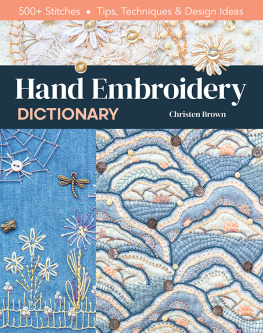
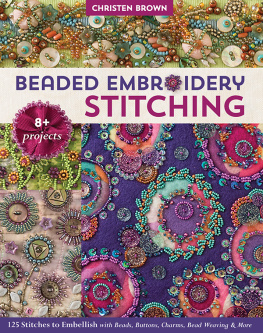
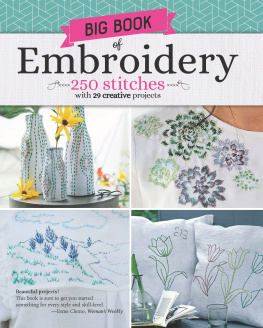
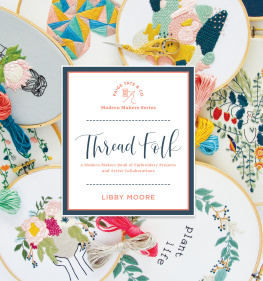

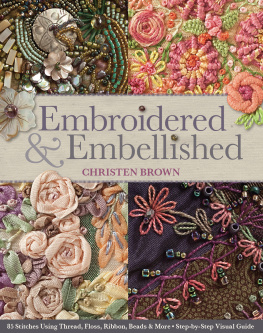
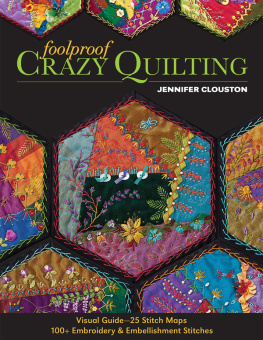
 HAPPY CREATING! I dedicate this book to all of my students, both
HAPPY CREATING! I dedicate this book to all of my students, both Tandletons, 1 1 Hanah Silk habotai ribbon worked into button shapes and embroidered with traditional and raised and textured stitches, worked in Wildflower threads by the Caron Collection
Tandletons, 1 1 Hanah Silk habotai ribbon worked into button shapes and embroidered with traditional and raised and textured stitches, worked in Wildflower threads by the Caron Collection  SPECIAL ACKNOWLEDGMENTS I have been fortunate to have the most wonderful people helping me throughout the process of designing, writing, editing, and photographing this book. I would like to thank each and every person whose expertise has touched these pages. Special thanks go to Maryanne, Liz, and Dianeyou know how special you are, and I do appreciate you. I would also like to thank my daughter, Gwen, for the use of her pretty hands in the step-out directions.
SPECIAL ACKNOWLEDGMENTS I have been fortunate to have the most wonderful people helping me throughout the process of designing, writing, editing, and photographing this book. I would like to thank each and every person whose expertise has touched these pages. Special thanks go to Maryanne, Liz, and Dianeyou know how special you are, and I do appreciate you. I would also like to thank my daughter, Gwen, for the use of her pretty hands in the step-out directions. Elizabeths Garden, 2 3 Silk broadcloth embroidered with silk embroidery ribbon, silk thread, silk rococo trim, and silk ribbonwork flowers
Elizabeths Garden, 2 3 Silk broadcloth embroidered with silk embroidery ribbon, silk thread, silk rococo trim, and silk ribbonwork flowers 
 California Poppies tote bag Hand embroidery continues to be my favorite form of needle arts, because of the variety of techniques and materials it encompasses.
California Poppies tote bag Hand embroidery continues to be my favorite form of needle arts, because of the variety of techniques and materials it encompasses. Shisha mirror embroidery, India The cross-stitch, so popular today in counted canvas work, is used throughout Europe and the Middle East as a border and fill-in stitch, without the help of a counted canvas or grid.
Shisha mirror embroidery, India The cross-stitch, so popular today in counted canvas work, is used throughout Europe and the Middle East as a border and fill-in stitch, without the help of a counted canvas or grid.  Cross-stitch, South Asia The satin stitch shows up in rich polychromatic silk shawls from Spain and China.
Cross-stitch, South Asia The satin stitch shows up in rich polychromatic silk shawls from Spain and China. From China, blue fabric satin stitch and Chinese knot, with chain and outline stitches on the ribbon trim Laid and couched threads have been used with many different materials over the centuries. In the beginning, real metal was used to create rich, opulent, and exquisitely embellished textiles, often incorporating glass or real jewels. Now the threads are made of synthetic fibers and materials, though they still retain a rich opulence.
From China, blue fabric satin stitch and Chinese knot, with chain and outline stitches on the ribbon trim Laid and couched threads have been used with many different materials over the centuries. In the beginning, real metal was used to create rich, opulent, and exquisitely embellished textiles, often incorporating glass or real jewels. Now the threads are made of synthetic fibers and materials, though they still retain a rich opulence.  Kalaga tapestry, Burma
Kalaga tapestry, Burma  Goldwork embroidery, China Tambour embroidery is a technique that came to us from France.
Goldwork embroidery, China Tambour embroidery is a technique that came to us from France. Chain stitch embroidery, Afghanistan and India This form of embroidery was adapted in the early twentieth century as a technique for applying pre-strung strands of beads and sequins to fabric. The process is reversed, with the strand of beads held against the right side of the fabric, which is held upside down in the frame, and the chain stitch on the wrong side of the fabric.
Chain stitch embroidery, Afghanistan and India This form of embroidery was adapted in the early twentieth century as a technique for applying pre-strung strands of beads and sequins to fabric. The process is reversed, with the strand of beads held against the right side of the fabric, which is held upside down in the frame, and the chain stitch on the wrong side of the fabric.